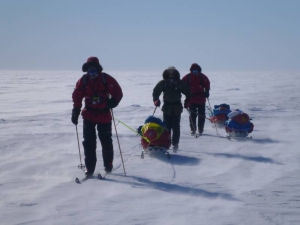HeadwindFor the first time, the weather has stopped us. Halfway through what should have been our next-to-last stretch we were obliged to throw in the towel and admit that the wind had defeated us. By then it had picked up to near gale force and we decided to set up camp while we were still in control. We didn’t dare do otherwise. Luckily the temperature had shot up to -15 to -20°C. Now both tents are firmly anchored and entrenched and the storm can have its way.
“Heard no noise in the ice during the night. No cracks in sight. Unfortunately the little light N’ly breeze managed to force the fog in.”– Amundsen on this day 100 years ago (Read more …)  The wind agreed well with the weather forecasts we had received, which predicted that it will last a couple more days. At the moment, we feel a bit of anxiety about whether or not we will be able to continue southward tomorrow morning.
The phenomenon called catabatic winds is common in Antarctica. These winds arise through the force of gravity, when cold, heavy air flows like a river along the ground. The steeper the terrain, the stronger the wind. One evening at Union Glacier we saw a cloud of snow appear suddenly at one of the glacier fronts nearby. Then the temperature had fallen enough for the cold air to start tumbling down the glacier. Such winds can be fierce: gale force winds are common. Once we get high up on Axel Heiberg Glacier on our way up to the plateau, it is very likely that we will have to struggle against catabatic winds.
The wind agreed well with the weather forecasts we had received, which predicted that it will last a couple more days. At the moment, we feel a bit of anxiety about whether or not we will be able to continue southward tomorrow morning.
The phenomenon called catabatic winds is common in Antarctica. These winds arise through the force of gravity, when cold, heavy air flows like a river along the ground. The steeper the terrain, the stronger the wind. One evening at Union Glacier we saw a cloud of snow appear suddenly at one of the glacier fronts nearby. Then the temperature had fallen enough for the cold air to start tumbling down the glacier. Such winds can be fierce: gale force winds are common. Once we get high up on Axel Heiberg Glacier on our way up to the plateau, it is very likely that we will have to struggle against catabatic winds.
Position: S 82 19.139, W 166 15.255
Temperature: -16 °C wind: 10 m/s from the south Distance traversed: 27 km Distance behind Amundsen: 227 km Did you know that when you run out of things to talk about, you talk about the weather?
The weather changes dramatically as you move from the inland to the coast of Antarctica, rather like what you see in Norway, but more extreme. |
South Pole 1911–2011 is an informational outreach project run by the Norwegian Polar Institute
Contact person:


